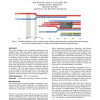Free Online Productivity Tools
i2Speak
i2Symbol
i2OCR
iTex2Img
iWeb2Print
iWeb2Shot
i2Type
iPdf2Split
iPdf2Merge
i2Bopomofo
i2Arabic
i2Style
i2Image
i2PDF
iLatex2Rtf
Sci2ools
AVI
2010
2010
Tracing genealogical data with TimeNets
We present TimeNets, a new visualization technique for genealogical data. Most genealogical diagrams prioritize the display of generational relations. To enable analysis of families over time, TimeNets prioritize temporal relationships in addition to family structure. Individuals are represented using timelines that converge and diverge to indicate marriage and divorce; directional edges connect parents and children. This representation both facilitates perception of temporal trends and provides a substrate for communicating nonhierarchical patterns such as divorce, remarriage, and plural marriage. We also apply degree-of-interest techniques to enable scalable, interactive exploration. We present our design decisions, layout algorithm, and a study finding that TimeNets accelerate analysis tasks involving temporal data. ACM Classification: H.5.2: User Interfaces
AVI 2010 | Edges Connect Parents | Most Genealogical Diagrams | Software Engineering | Temporal Relationships |
| Added | 29 Oct 2010 |
| Updated | 29 Oct 2010 |
| Type | Conference |
| Year | 2010 |
| Where | AVI |
| Authors | Nam Wook Kim, Stuart K. Card, Jeffrey Heer |
Comments (0)

